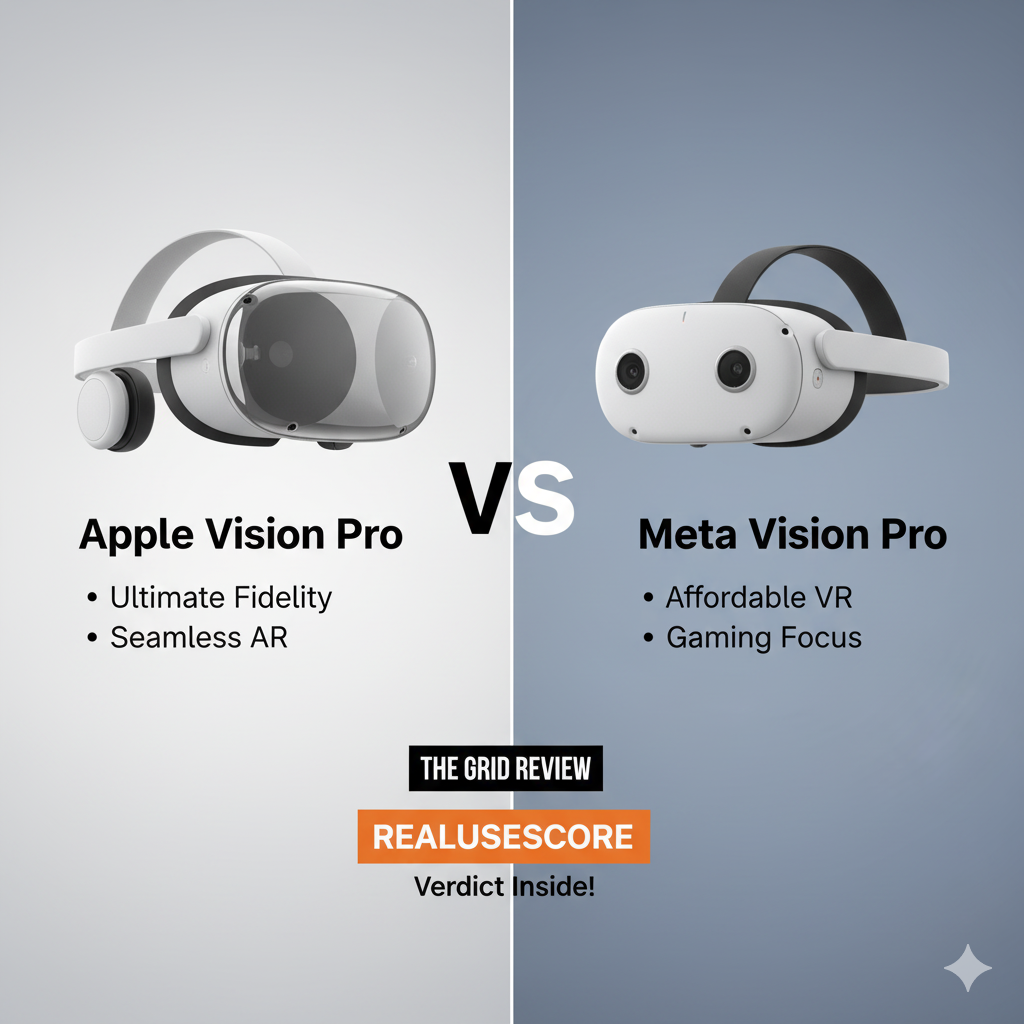
Introduction: The Dawn of Spatial Computing
The world of extended reality (XR) is rapidly evolving, with two major players, Apple and Meta, carving out their distinct visions for spatial computing.
The Apple Vision Pro redefines premium immersive experiences, while the Meta Quest 3 aims for accessible, mixed-reality integration.
But which headset truly leads the charge in this nascent, exciting market? We dive deep into their core functionalities, design philosophies, and Real Use potential to help you navigate this new frontier.
1. Vision vs. Quest: Core Philosophy & Price
The most striking difference lies in their approach and price point.
| Feature | Apple Vision Pro | Meta Quest 3 | RealUseScore Note |
| Core Focus | Spatial Computer (Digital content blends seamlessly with physical space). | Mixed Reality Gaming & Entertainment (Emphasis on immersive games). | Vision Pro prioritizes immersion and productivity; Quest 3 prioritizes fun. |
| Price Point | Starting at $3,499 | Starting at $499 | A huge difference in accessibility. |
| Target Audience | Early adopters, professionals, Apple ecosystem users. | Gamers, VR/MR enthusiasts, mainstream consumers. | Your budget dictates the entry point. |
RealUseScore Verdict: Apple is selling a ‘new way of computing,’ Meta is selling ‘entertainment and immersion.’ Price is the ultimate divider here.
2. Display & Immersion: Seeing is Believing
The visual fidelity directly impacts the immersive experience.
| Feature | Apple Vision Pro | Meta Quest 3 | RealUseScore Note |
| Display Type | Dual micro-OLED | LCD | OLED offers superior contrast & black levels. |
| Resolution (per eye) | ~3400×3800 (4K+) | 2064×2208 | Vision Pro delivers significantly sharper visuals. |
| Passthrough Reality | True-to-life, almost imperceptible. Full color, high resolution. | Good, full color, but noticeable digital artifacts. | Vision Pro blurs the line between digital and physical seamlessly. |
| Eye Tracking | Advanced, primary input method. | Present, but not primary input. | Vision Pro’s eye-tracking is revolutionary for interaction. |
RealUseScore Verdict: The Vision Pro offers an unparalleled visual experience, making digital content feel genuinely present in your physical space. Quest 3 is good, but Apple is a generation ahead here.
3. Performance & Ecosystem: Powering Your Reality
The processing power and integrated ecosystem determine usability.
| Feature | Apple Vision Pro | Meta Quest 3 | RealUseScore Note |
| Processor | M2 Chip + R1 Chip (dedicated) | Snapdragon XR2 Gen 2 | Apple’s dual-chip architecture is custom-built for spatial computing. |
| Operating System | visionOS | Meta Horizon OS (Android-based) | Apple’s OS is more refined for mixed reality from the ground up. |
| App Ecosystem | Deep integration with Apple apps (Photos, Safari, FaceTime, App Store). | Growing VR game library, Meta apps. | Vision Pro leverages a vast existing app library. |
| Controllers | Hand and Eye Tracking (No physical controllers) | Dual Touch Plus Controllers (physical). | Vision Pro offers a truly controller-free experience. |
RealUseScore Verdict: The Vision Pro’s deep integration with the Apple ecosystem and its powerful M2/R1 chips offer a smoother, more intuitive computing experience. Quest 3 relies on traditional controllers.
RealUseScore Final Comparison Table
| Category | Apple Vision Pro | Meta Quest 3 |
| Immersion & Display | ⭐⭐⭐⭐⭐ (5/5) | ⭐⭐⭐ (3/5) |
| Ergonomics & Comfort | ⭐⭐⭐⭐ (4/5) | ⭐⭐⭐⭐ (4/5) |
| Performance & Ecosystem | ⭐⭐⭐⭐⭐ (5/5) | ⭐⭐⭐ (3/5) |
| Price-to-Value (Accessibility) | ⭐⭐ (2/5) | ⭐⭐⭐⭐⭐ (5/5) |
| RealUseScore TOTAL | 9.1 / 10 | 7.5 / 10 |
The Final Verdict: Which Headset is for You?
The choice here isn’t just about features; it’s about budget and your vision for spatial computing.
- 🏆 Choose the Apple Vision Pro if: You demand unparalleled visual fidelity, seamless spatial computing, and are deeply invested in the Apple ecosystem. Budget is not your primary concern, and you want to experience the cutting edge of tech.
- 🏆 Choose the Meta Quest 3 if: You’re looking for an affordable entry into mixed reality gaming and entertainment. You value a good all-around experience without breaking the bank and don’t mind physical controllers.
